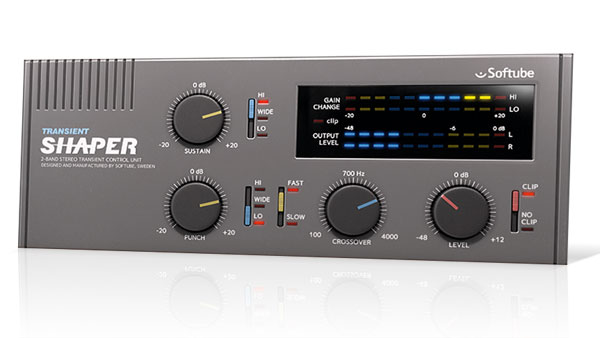MusicRadar Verdict
With two bands of processing elevating it above most of the competition, Transient Shaper comes highly recommended.
Pros
- +
Simple interface, good metering. Two bands offer just enough flexibility. Great on drums. Useful on many other instruments. CPU efficient.
Cons
- -
We'd prefer totally independent controls for each band.
MusicRadar's got your back
Transient Shaper (VST/AU/AAX) expands upon the transient shaping algorithm from Softube's Console 1, the main addition being dual-band operation with adjustable crossover (100Hz-4kHz).
It retains the two controls of the Console 1 version - Sustain and Punch, providing +/-20dB of adjustment to the sustain and attack stages respectively - with switches for setting which frequencies are processed by each: Hi, Lo or Wide (both). This provides some flexibility, though not quite as much as you'd get with completely independent controls for each band.
"The dual-band architecture makes it more than just a drum processing tool, enabling a wide range of dynamic processing colours"
The Punch control is augmented by a Fast/ Slow transients slider, which not only adjusts the detection circuit accordingly, but also influences the duration of the applied transient shaping.
And while we're talking detector circuits, the block diagram reveals that the Punch detector circuit analyses the stereo signal, while the Sustain detector analyses the L+R combined mono signal.
Following the main controls are global output Level and 0dB soft Clip on/off. Levels can soon get hot when applying transient shaping, so the clipper is useful, but it's good that you can switch it off and overload the channel, instead, should you wish. Finally, Transient Shaper includes both output level and separate Hi and Lo gain change meters (+/-20dB).
Unsurprisingly, Transient Shaper is great on drums, high Punch settings combining with either very short or long Sustain to greatly enhance hits, and transient settings towards the Fast end of the range being particularly good for bringing out kick drum click and snare drum snap.
Nevertheless, Transient Shaper is also excellent at softening off sounds. Softube suggest using lower Punch settings to give overly harsh modern recordings a vintage feel, but if you're used to calling on regular compression to smooth out the sharp edges of sounds, you'll find this to be a quicker way of doing it, mainly thanks to the Crossover control.
Want all the hottest music and gear news, reviews, deals, features and more, direct to your inbox? Sign up here.
Having dialled in your desired transient colour, you simply shift the Crossover until only the frequencies you want to enhance (or soften) are processed.
The shape of things
Overall, Transient Shaper feels like much less of a blunt instrument than its single-band counterparts, making processing of more complex sounds such as vocals, guitars and keyboards a more viable proposition.
Although one wouldn't normally reach for a transient shaper when working on a lead vocal, this particular plugin is ideal for adding bite.
As mentioned, we did find ourselves lamenting the lack of separate Punch and Sustain controls for each band at points in the testing period, as well as an adjustable crossover slope.
Even so, Transient Shaper is a well-conceived plugin that offers plenty of control without being complicated and CPU hungry. The dual-band architecture makes it more than just a drum processing tool, enabling a wide range of dynamic processing colours - both subtle and overt - with the convenience of a non level-dependent design.
Once you've tried it, you may well find it difficult to go back to the single-band alternatives.
Computer Music magazine is the world’s best selling publication dedicated solely to making great music with your Mac or PC computer. Each issue it brings its lucky readers the best in cutting-edge tutorials, need-to-know, expert software reviews and even all the tools you actually need to make great music today, courtesy of our legendary CM Plugin Suite.

